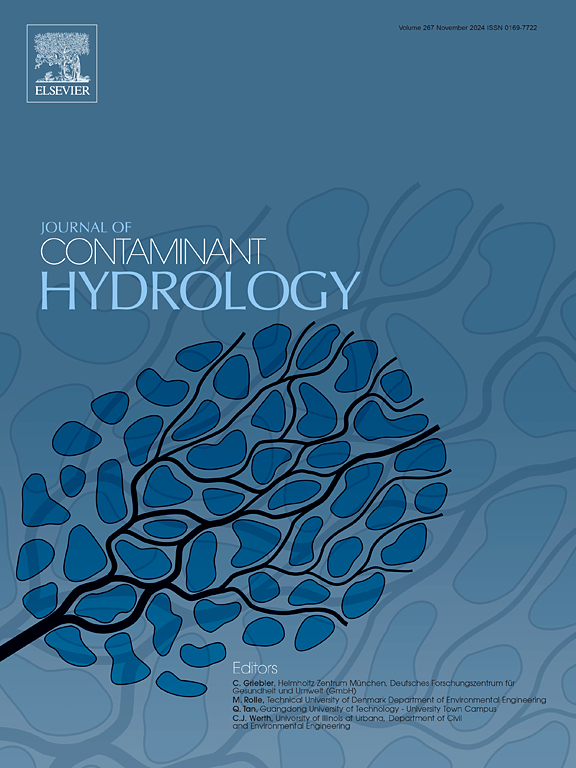Modeling of hydrogeochemical processes influencing uranium migration in anthropized arid environments with application to the Teloua aquifer
IF 3.5
3区 环境科学与生态学
Q2 ENVIRONMENTAL SCIENCES
引用次数: 0
Abstract
Sandstone-hosted uranium is mined in the Sahel regions of Niger. The Teloua aquifer is located beneath the ore-processing facilities of one such former mine, COMINAK. The pores of the sandstone bedrock are partially filled by tosudite, a clay with sorption capacities. The local groundwater presents a strong oxidizing signature and very low water recharge. This study aims to determine the geochemical baseline of anthropogenic activity for uranium under such extreme conditions. The major and trace elements of both the contaminated and the pristine local groundwaters were sampled and analyzed to develop geochemical and reactive transport models. Kd distribution coefficients were calculated a posteriori from the mechanistic simulations. The entire water chemistry, with large variations in calcium, carbonate and sulfate concentrations, had to be taken into account to properly simulate the speciation and migration of U(VI) in the aquifer locally affected by the mining activities. U(VI) sorption significantly decreases during the propagation of the contaminant plume, due to the formation of CanUO2(CO3)3(4-2n)- complexes that were clearly demonstrated by TRLFS acquisition. The sorption of UO2(CO3)n(2−2n) can play a key role in the immobilization of U(VI). The mitigating factors for U(VI) are sorption on clay and the dispersion/dilution of the contaminated source terms within the groundwater, in which the strong ternary complexes are less important. There should be an efficient immobilization of fixed anthropic uranium by natural attenuation once the contaminant source terms have become depleted.

人为干旱环境中影响铀迁移的水文地球化学过程模拟及其在特鲁瓦含水层的应用。
砂岩中的铀是在尼日尔的萨赫勒地区开采的。Teloua含水层位于其中一个这样的前矿山COMINAK的矿石加工设施下方。砂岩基岩的孔隙部分被一种具有吸附能力的粘土土所填满。当地地下水呈现出强烈的氧化特征,补给水量极低。本研究旨在确定这种极端条件下铀的人为活动地球化学基线。对污染地下水和未污染地下水的主要元素和微量元素进行了采样和分析,建立了地球化学和反应输运模型。Kd分布系数由机理模拟后验计算得到。必须考虑到钙、碳酸盐和硫酸盐浓度变化很大的整个水化学,以适当地模拟受采矿活动局部影响的含水层中U(VI)的形态和迁移。在污染物羽流传播过程中,由于CanUO2(CO3)3(4-2n)-络合物的形成,U(VI)吸附显著减少,TRLFS采集清楚地证明了这一点。UO2(CO3)n(2-2n)的吸附对U(VI)的固定化起关键作用。黏土对U(VI)的吸附和地下水中污染源项的分散/稀释是U(VI)的缓解因素,其中强三元配合物的作用较小。一旦污染物源项耗尽,应通过自然衰减有效地固定固定的人为铀。
本文章由计算机程序翻译,如有差异,请以英文原文为准。
求助全文
约1分钟内获得全文
求助全文
来源期刊

Journal of contaminant hydrology
环境科学-地球科学综合
CiteScore
6.80
自引率
2.80%
发文量
129
审稿时长
68 days
期刊介绍:
The Journal of Contaminant Hydrology is an international journal publishing scientific articles pertaining to the contamination of subsurface water resources. Emphasis is placed on investigations of the physical, chemical, and biological processes influencing the behavior and fate of organic and inorganic contaminants in the unsaturated (vadose) and saturated (groundwater) zones, as well as at groundwater-surface water interfaces. The ecological impacts of contaminants transported both from and to aquifers are of interest. Articles on contamination of surface water only, without a link to groundwater, are out of the scope. Broad latitude is allowed in identifying contaminants of interest, and include legacy and emerging pollutants, nutrients, nanoparticles, pathogenic microorganisms (e.g., bacteria, viruses, protozoa), microplastics, and various constituents associated with energy production (e.g., methane, carbon dioxide, hydrogen sulfide).
The journal''s scope embraces a wide range of topics including: experimental investigations of contaminant sorption, diffusion, transformation, volatilization and transport in the surface and subsurface; characterization of soil and aquifer properties only as they influence contaminant behavior; development and testing of mathematical models of contaminant behaviour; innovative techniques for restoration of contaminated sites; development of new tools or techniques for monitoring the extent of soil and groundwater contamination; transformation of contaminants in the hyporheic zone; effects of contaminants traversing the hyporheic zone on surface water and groundwater ecosystems; subsurface carbon sequestration and/or turnover; and migration of fluids associated with energy production into groundwater.
 求助内容:
求助内容: 应助结果提醒方式:
应助结果提醒方式:


